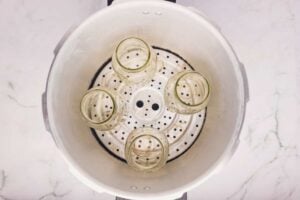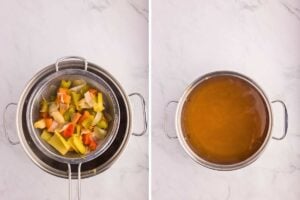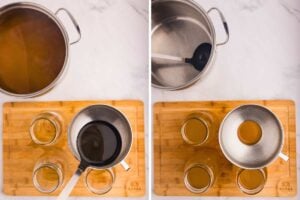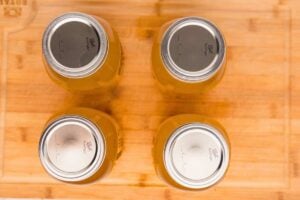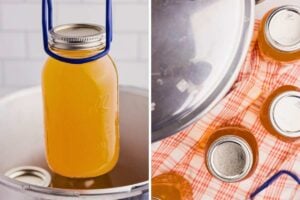How to Make Canned Vegetable Stock
This vegetable stock for canning is the perfect way to use leftover veggies in the fridge and add flavor to your soups and stews. This is a frugal way to fill your pantry, getting everything you can from your groceries. Do not rush the simmer time. A good long simmer is how you’ll get the most flavor.
This recipe uses pressure canning because of the low-acid ingredients. Do not use a waterbath canner!
Vegetable Stock for Canning
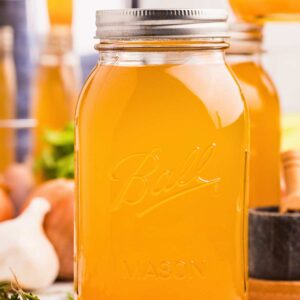
Equipment
- Mason jars
- strainer
- Cheesecloth
- Large pot
Ingredients
- 10 carrots peeled and roughly chopped (about 1 lb)
- 6 celery stalks roughly chopped
- 2 medium onions roughly chopped
- 2 bell peppers roughly chopped and seeds removed (any color)
- 1 parsnip peeled and roughly chopped
- 1 large tomato or 3 Roma chopped or left whole
- 6 cloves garlic smashed and papers removed
- 4 bay leaves
- 4 sprigs oregano or 1 tablespoon dried oregano
- 4 sprigs thyme or 1 tablespoon dried thyme
- 4 sprigs rosemary or 1 tablespoon dried rosemary
- 1 tablespoon salt optional
- 1 tablespoon whole black peppercorn
- 32 cups water 2 gallons
Save This Recipe
You'll join my email list which you will love. And if you don't, unsubscribe in one click. ❤️
Instructions
- Cook. In a large pot, add all of the ingredients. Set it over medium heat and bring it to a boil. Once the mixture is boiling, reduce the heat to simmer, cover, and allow to simmer for about 2 hours.
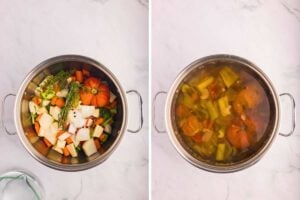
- Prep jars. Halfway through the simmering time, prepare the jars for canning. Wash the jars, lids, and rings with hot soapy water. Transfer the jars to your pressure canner. Fill the jars with water, and the canner to the water fill line (about 3 inches). Place the canner over medium heat.

- Strain. Strain the broth over a fine mesh strainer. Transfer back into the large pot and bring back to a boil. (If you do not have a fine mesh strainer or want a clearer broth, line a strainer with 2 layers of cheesecloth.)

- Fill jars. Ladle the hot broth into the hot jars, leaving a 1-inch headspace.

- Wipe rims. Wipe the rims with a clean, damp cloth (you can dampen the cloth or paper towel with white vinegar)

- Secure jars. Place the lids and rings on the jars. Tighten so they are fingertip tight.

- Process. Transfer jars to the pressure canner and fill with water until the fill line (or about 3 inches of water). (Add a splash of white vinegar to prevent mineral deposits from forming on the outside of your jars.) Place the lid on and lock it in place. Set the heat to medium-high heat. Allow the canner to vent steam continuously. Once steaming, set the timer for 10 minutes. After 10 minutes, set the canner to 11 lbs (digital) or place weight (10 lbs). Once the canner is up to pressure, set the time for 35 minutes (quart jars) or 30 minutes (pint jars). If the pressure goes below the set pressure, stop the timer, bring the pressure back up, and restart the timer.

- Vent. Once the timer goes off, remove the canner from the heat and allow the pressure to drop naturally. When the pressure hits zero, remove the weight (or set the dial to 0) and allow the steam to stop venting. Wait 10 minutes once the steam stops venting to remove the lid.
- Cool. Remove the lid, tilting the lid away from your face, and allow the jars to rest in the canner for 5 minutes. Transfer the jars to a heat-safe area and allow them to cool for 12-24 hours.

- Check seals. After 24 hours, check the seal by pressing the middle of the lid. If it stays down, your jars are properly sealed. Remove the rings and store them in a cool, dark place for 12 to 18 months, depending on your lid manufacturer’s recommendations. If a proper seal has not happened, refrigerate the broth and use it within 5 days.
Notes
- Removing the canner’s lid before the pressure has fully released can result in jars shattering in your canner.
- The USDA recommends that your broth stay under pressure for the whole time for safe storage.
Nutrition
Having vegetable stock on hand is super handy when I want to make soups, stews, or add some extra flavor to a dish. I like cooking rice in it and serving it with broiled brown sugar salmon.
A Newsletter you’ll love
Daily recipes from the farmhouse, Sunday meal plans, seasonal ideas, straight from my kitchen to your inbox.
I promise to keep your email address safe. Unsubscribe at any time

I also love knowing what’s in it – my sad-looking veggies from the fridge 😅.
Key Ingredients and Tools
The right tools and ingredients will make this recipe even easier.

- Pressure canner. Canning stock safely requires a pressure canner, not just a water bath canner. Pressure canning destroys harmful bacteria, allowing for safe, long-term storage.
- Cheesecloth. This inexpensive material is great for straining the stock and removing tiny bits of vegetables. You can usually find cheesecloth in the baking aisle near the aluminum foil and parchment paper. If you don’t have any, you can use a fine-mesh strainer or even a coffee filter in a pinch.
- Fresh herbs. Using fresh herbs like oregano, thyme, and rosemary boosts the flavor of your stock. Look for bright, perky bunches in the produce section of your grocery store. If you can’t find fresh, you can substitute it with dried, but use about a tablespoon of dried for every four fresh sprigs.
With these key items, you’ll be well on your way to canning delicious homemade vegetable stock.
Troubleshooting and Help
Absolutely! This recipe is just a starting point. Feel free to swap in your favorite vegetables or use what you have on hand. Just be sure to keep the proportions roughly the same. Things like mushrooms, leeks, and turnips would all be delicious additions.
It’s not strictly necessary, but peeling does give you a cleaner-looking stock. If you’re short on time or don’t mind a bit of rustic charm, you can skip peeling the carrots and parsnip.
Cloudy stock is usually caused by boiling the vegetables too vigorously. Aim for a gentle simmer to prevent this. Also, make sure you strain the stock well through cheesecloth or a fine-mesh strainer.
While pressure canning is the safest method for preserving stock, you can still make this recipe and store the stock in the refrigerator for up to 5 days or freeze it for longer storage. Just skip the canning steps and pour the cooled stock into airtight containers for storage.
If you have any more questions, leave me a comment. I’m always happy to help.
There you have it! A straightforward canning recipe that’s a great pantry staple. Use it in soups and stews, as a substitute for chicken broth, or to add flavor to rice and other dishes. Get the most out of your leftover veggies with this recipe.

Love,


